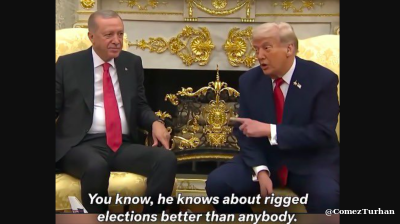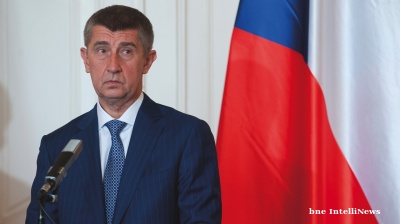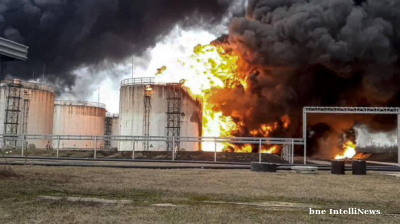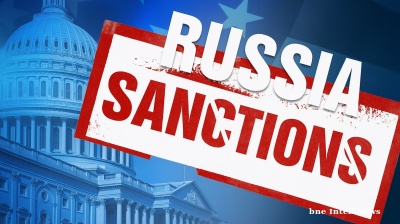Likely not, at least in the short term, but Russia won’t stop threatening Ukraine until it believes that Ukraine doesn’t pose a future threat to the current regime in Russia.
That doesn’t mean that Ukraine constitutes a military threat to Russia. It doesn’t. Instead, the threat posed by Ukraine is to the future stability of the current regime in Russia, primarily by offering Russians an alternative to the kleptocratic totalitarian system under which Russia is currently governed. Often, Western leadership and Western media seem to unwittingly contribute to the Russian narrative, that Ukraine is unstable and unreliable. This has been the case since the beginning of the Revolution of Dignity and continues today.
A few days ago I had correspondence with a friend of mine, a Ukrainian, who provided significant support during Euromaidan and since then, from his own pocket, he has provided units of the Ukrainian Army with provisions and equipment such as night-vision equipment. Based on his continued contacts with the Ukrainian Army, he puts the chances of Russia making a significant immediate military move against Ukraine at around five percent.
Recent moves by Ukraine, against influential Ukrainian fifth columnists, most prominently Viktor Medvedchuk, who have operated with impunity inside Ukraine for years, is unsettling to Russia. Medvedchuk is the leader of the largest opposition Party in the Ukrainian Parliament. Current Russian military moves along the frontier opposite Donetsk and Luhansk, as well in occupied Crimea, plus moves by Belarusian forces closer to its border with Ukraine, moves that are all out in the open for everyone to see, are likely designed to intimidate Ukraine, as well as to create doubt among Ukraine’s Western Partners, especially “Normandy Format” members France and Germany, as to whether or not supporting Ukraine is worth the cost, in lost business with Russia, and by making Ukraine’s moves against the fifth columnists appear to be the cause of increased conflict with Russia.
Since the end of the Revolution of Dignity, in February 2014, Russian military superiority over Ukraine has deteriorated in relative terms, to the point where Russia launching a direct military operation in Ukraine will likely result in a large number of Russian casualties and will be unlikely to achieve any logical objectives. In March 2014, soon after the end of the Revolution of Dignity, Ukraine had only 6,000 combat-ready troops. After absorbing Crimea, Russia could have walked into Southern and Eastern Ukraine virtually unopposed, the land that Russia refers to as “Novorosiya.” Russia likely believed that there was no need for a direct invasion. Moscow may well have concluded, wrongly as it turned out, that Russian-speaking Ukrainians living in this part of Ukraine could do their work for them. During the spring of 2014 there was civil unrest in both Kharkiv and Odesa, likely instigated by Russia and designed to undermine Ukraine and install pro-Russian authority. In both cases it failed, with especially tragic consequences in Odesa. This failure was an early example of Russia’s continued misunderstanding of Ukrainian society and politics. In my opinion, Putin continues to make made one mistake in Ukraine after another, the latest of which is Russia’s assumption that activities of their fifth columnists could continue unimpeded in Ukraine.
I come to my conclusion, that Russia is very unlikely in the near term to launch a further incursion into Ukraine, partly from personal experience. Except for short absences for work or vacation I, along with my family, was in Kyiv during the entire Revolution of Dignity, as well as the period after the Revolution, through July 2014, that included the Russian invasion and annexation of Crimea, the Russian invasion of Donbas, and the beginning of the Ukrainian counterattack in Donbas, starting with the re-taking of Sloviansk. During this same period, what I observed and experienced, from Western media and observers from outside Ukraine, consisted of the following:
Bylines, from the New York Times and other national publications covering events in Ukraine, virtually all of which were posted from Moscow.
In the middle of March 2014, three weeks after the end of the Revolution of Dignity when the barricades on Independence Square were still intact, my family and I were invited for dinner in Kyiv with an official delegation from the United States, headed by the late US Senator, John McCain. We were kindly invited by my cousin, who was a member of the delegation. Other than US Embassy personnel, we were the only private residents of Kyiv at the dinner. During the dinner we were asked: “What is our exit strategy?” The question came from someone at a very high level of the US Government.
Emails from “friends” in the US containing the subject line “Here They Come”, referring to Russia. I was angry at the callousness of these emails.
An email from a member of my immediate family in the US suggesting that we leave Ukraine, posed as if I was somehow unaware of the situation in the city where we lived.
Information from a college classmate, who manages a hedge fund with Ukrainian investments, that he was receiving solicitations from the Russian Embassy saying: “Let’s get back to business.”
Analysis by Stratfor, a well-respected publication covering national security whose recipient list includes many high-placed officials in both the US and Europe, that included a map showing the prospect of a World War II style “double envelopment” of Kyiv by Russian armour.
During a visit to Washington listening to a retired senior US military officer working for a well-respected strategic consulting firm, telling me that Russia can take Kyiv any time it wanted to, and therefore we should leave. After all, Putin said they could take Kyiv in two weeks.
In each one of these examples, it is quite possible that covert and overt Russian disinformation was at work, the covert portion done in a way where it wasn’t evident to the recipients. Given the sources, the intent would’ve been to sow doubt in the West, both about the viability of Ukraine as a country, and the resulting efficacy of offering support.
Personally I had become cynical about “advice” such as this. By then, we had lived through the Revolution of Dignity, where on the morning of February 20, 2014 over 100 people were murdered by sharpshooters likely acting under orders from the Yanukovych Government. On the night of February 18 and 19, the protests came very close to collapsing and, on the afternoon of February 20 there were rumours that the Yanukovych Government had closed the bridges across the Dnieper River. If the rumours were true, it meant we were trapped in Kyiv.
Then there were the “Titushki”, thugs whom the Yanukovych Government enlisted to complement their Interior Ministry police, the “Berkut.” Many were released from jail, given baseball bats and $20 a day, and told to attack and abduct protesters, and intimidate ordinary citizens. On January 22, 2014 I had one encounter with three Tetushki that, fortunately for me, amounted to nothing. By this time, I wasn’t bothered much by Russia. Maybe I should have been.
In April 2014, a warm early spring day in Kyiv, I ran into a friend and his wife on the street. At the time there was heightened talk about a Russian invasion. My friend, a Scotsman, managed a large farming operation in Ukraine. I asked him what he was doing. He answered, in his finest Scottish brogue, "Plantin'." For me, that confirmed our decision to stay put.
In July and August 2014, Ukraine’s reconstituted armed forces re-took approximately half of the territory in Donbas taken by the Russians and their proxies. Ukraine would have likely re-taken all of Donbas, if it weren’t for a massive Russian counterattack in September 2014, especially at a town near Donetsk called Ilovaisk and later, in February 2015, at Debaltseve, a key road and rail junction that, if Ukrainians had held the town, would have split the occupied territories in two.
Since Ukraine’s loss at Debaltseve and the signing of the Minsk II Agreements soon after, Ukraine has hardened the line of contact around the occupied territories. Behind the lines, there are likely trained partisans. Equally important, Ukraine, with backing from Western development finance institutions, has made a great effort, with mixed success, to improve economic conditions for people living near the line of contact. Even so, roughly 200,000 Ukrainian children suffer mental trauma from living and attending school near the line of contact, where they are in constant danger of shelling. Since the start of the fighting 14,000 have died and there are approximately 1.6mn internally displaced persons, including almost all of the occupied territories’ “best & brightest”, most of whom are now living productive lives in Ukraine.
Given the history of Russian threats and intimidation, what are the specific reasons that contribute to the likelihood that Russia won’t invade in the near term? These include the following:
Bad roads: Like in the states of Vermont and New Hampshire, and likely in many parts of Europe, March and April is known as “Mud Season.”
The Russian Draft: April is when most new draftees enter the Russian Army, replacing those whose draft terms have ended. It takes 90-120 days to train draftees to the point where they are ready to engage in combat operations. Most of the recent Russian military operations, in Georgia, in Donbas, and even in Chechnya, have taken place between August and the following February.
Hardened Objectives: The two objectives of a possible Russian invasion that are most discussed are: the dam in Kherson Oblast, in Southern Ukraine, that supplied Crimea with virtually all of its water, and the oft-mentioned “land bridge,” along the shore of the Sea of Azov between Donbas and Crimea. The former has been hardened and it is possible, if an invasion were to take place, that Ukraine would destroy the dam. The “land bridge” would require Russian occupation of two major cities, Mariupol and Berdyansk, plus holding a 400-km-long salient with the near certainty of continued partisan attacks.
The Need for Air Operations: Any Russian invasion, even an unlikely invasion from the north, involving Belarus, would require Russia to employ fixed and rotary-winged aircraft. Employing aircraft would likely subject Russia, and Belarus if it became involved in an invasion of Ukraine at Russia’s behest, to the most crippling Western sanctions, including but likely not limited to getting kicked out of the SWIFT System.
What can the West do, especially the United States, to support Ukraine and, in addition, discourage Russia from even considering military operations against Ukraine?
Behind-the-Scenes Pressure for Reforms: The new Biden administration appears to be doing this, wisely foregoing public lecturing that Vice-President Biden undertook in 2015 and 2016. Western countries now appear to have marginally greater leverage over Ukraine.
US joins the Normandy Four, or Minsk II: The Biden administration is viewed by Ukraine as a strong supporter. Conversely, Ukraine almost certainly distrusts both Germany and France. There are significant elements in both countries that would like to restore ties with Russia. Germany and France recently agreed to hold talks with Russia regarding Ukraine, without including Ukraine. The current German government continues to support the completion of the Nord stream II gas pipeline, which would effectively bypass Ukraine’s existing pipeline network and deprive Ukraine of approximately $2bn per year in transit fees.
Complementing diplomatic moves should be upgraded military assistance, including:
Rotating F-35 fighter squadrons into bases in Western Ukraine, far enough from the fighting but close enough to send a message.
Rotating 1 or 2 Arleigh Burke Class destroyers with the Aegis air defence system into the Black Sea on an almost continual basis, capable of assisting Ukraine in air surveillance of Russian air operations in Crimea and Russian submarine operations in the Black Sea.
Offering Ukraine Oliver Hazard Perry Class destroyers – O.H. Perry Class destroyers have been discontinued by the US Navy, but they still operate in the navies of a number of other NATO countries. They can likely be upgraded to include more sophisticated sonar, ship-to-ship and ship-to-shore cruise missiles, and improved helicopter capabilities, including torpedoes and dipping sonar.
Interoperability between AWACS monitoring aircraft operated by NATO Ukrainian armed forces and intelligence. Although NATO AWACS planes flying from bases in Bulgaria and Romania were operating in the Black Sea after the Revolution of Dignity and during the Russian invasion of Crimea, they were not sharing information with Ukraine because of the risk of sources and methods falling into Russian hands. At the time and thanks to Yanukovych, Ukraine’s security and intelligence services were full of agents from Russia’s security services. Today, this is far less likely.
If the Biden administration really wants to show its “un-wavering commitment of the United States” to Ukraine’s sovereignty, it should be considering some or all of the above alternatives. This is particularly necessary because the current regime in Russia has an unwavering commitment to neutralising any threat from Ukraine, not necessarily by invading, but instead by stopping Ukraine’s move towards the rule of law and a free enterprise system by whatever means necessary. Success in Ukraine, through achieving the rule of law and free enterprise, is treated by the Russian regime as a threat to its survival.
Robert Homans is an international financial sector consultant based in Washington DC and tweets at @rhomansjr
Opinion

COMMENT: China’s new export controls are narrower than first appears
A closer inspection suggests that the scope of China’s new controls on rare earths is narrower than many had initially feared. But they still give officials plenty of leverage over global supply chains, according to Capital Economics.

BEYOND THE BOSPORUS: Consumed by the Donald Trump Gaza Show? You’d do well to remember the Erdogan Episode
Nature of Turkey-US relations have become transparent under an American president who doesn’t deign to care what people think.

COMMENT: ANO’s election win to see looser Czech fiscal policy, firmer monetary stance
The victory of the populist, eurosceptic ANO party in Czechia’s parliamentary election on October 6 will likely usher in a looser fiscal stance that supports growth and reinforces the Czech National Bank’s recent hawkish shift.

COMMENT: Ukraine's drone attacks on Russian refineries have probably reduced throughput by 30.4%, less than headline figures suggest
Ukraine has been hitting Russian refineries and caused a fuel crisis that has spead across multiple regions. The headline figure is that oil refining has been reduced by 38% since August, but digging into it and the reduction is likely less.




